The Intel Core i9-9900K at 95W: Fixing The Power for SFF
by Ian Cutress on November 29, 2018 8:00 AM ESTCPU Performance: System Tests
Our System Test section focuses significantly on real-world testing, user experience, with a slight nod to throughput. In this section we cover application loading time, image processing, simple scientific physics, emulation, neural simulation, optimized compute, and 3D model development, with a combination of readily available and custom software. For some of these tests, the bigger suites such as PCMark do cover them (we publish those values in our office section), although multiple perspectives is always beneficial. In all our tests we will explain in-depth what is being tested, and how we are testing.
All of our benchmark results can also be found in our benchmark engine, Bench.
Application Load: GIMP 2.10.4
One of the most important aspects about user experience and workflow is how fast does a system respond. A good test of this is to see how long it takes for an application to load. Most applications these days, when on an SSD, load fairly instantly, however some office tools require asset pre-loading before being available. Most operating systems employ caching as well, so when certain software is loaded repeatedly (web browser, office tools), then can be initialized much quicker.
In our last suite, we tested how long it took to load a large PDF in Adobe Acrobat. Unfortunately this test was a nightmare to program for, and didn’t transfer over to Win10 RS3 easily. In the meantime we discovered an application that can automate this test, and we put it up against GIMP, a popular free open-source online photo editing tool, and the major alternative to Adobe Photoshop. We set it to load a large 50MB design template, and perform the load 10 times with 10 seconds in-between each. Due to caching, the first 3-5 results are often slower than the rest, and time to cache can be inconsistent, we take the average of the last five results to show CPU processing on cached loading.
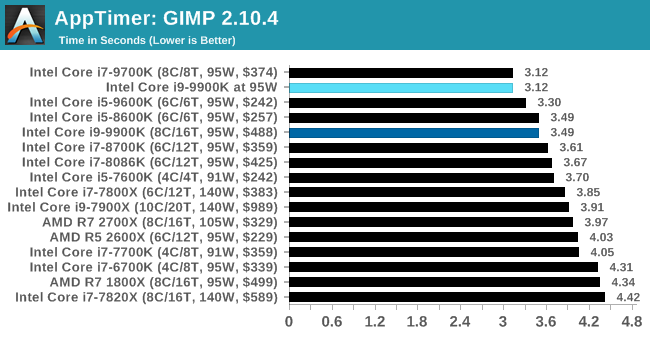
One of the interesting things in these benchmarks is that when in 95W mode, especially in shorter tests, the 9900K actually performs better than the full grunt settings. This could be because the system doesn't have to consider current limits of the power delivery, as 95W is the guaranteed limit no matter the loading.
FCAT: Image Processing
The FCAT software was developed to help detect microstuttering, dropped frames, and run frames in graphics benchmarks when two accelerators were paired together to render a scene. Due to game engines and graphics drivers, not all GPU combinations performed ideally, which led to this software fixing colors to each rendered frame and dynamic raw recording of the data using a video capture device.
The FCAT software takes that recorded video, which in our case is 90 seconds of a 1440p run of Rise of the Tomb Raider, and processes that color data into frame time data so the system can plot an ‘observed’ frame rate, and correlate that to the power consumption of the accelerators. This test, by virtue of how quickly it was put together, is single threaded. We run the process and report the time to completion.
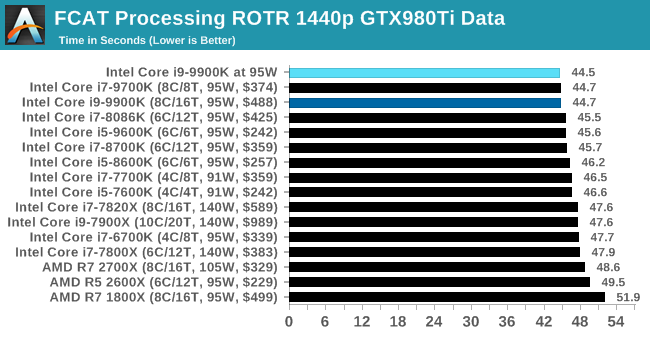
In a slightly longer test, the 9900K @ 95W eeks out the tiniest win.
3D Particle Movement v2.1: Brownian Motion
Our 3DPM test is a custom built benchmark designed to simulate six different particle movement algorithms of points in a 3D space. The algorithms were developed as part of my PhD., and while ultimately perform best on a GPU, provide a good idea on how instruction streams are interpreted by different microarchitectures.
A key part of the algorithms is the random number generation – we use relatively fast generation which ends up implementing dependency chains in the code. The upgrade over the naïve first version of this code solved for false sharing in the caches, a major bottleneck. We are also looking at AVX2 and AVX512 versions of this benchmark for future reviews.
For this test, we run a stock particle set over the six algorithms for 20 seconds apiece, with 10 second pauses, and report the total rate of particle movement, in millions of operations (movements) per second. We have a non-AVX version and an AVX version, with the latter implementing AVX512 and AVX2 where possible.
3DPM v2.1 can be downloaded from our server: 3DPMv2.1.rar (13.0 MB)
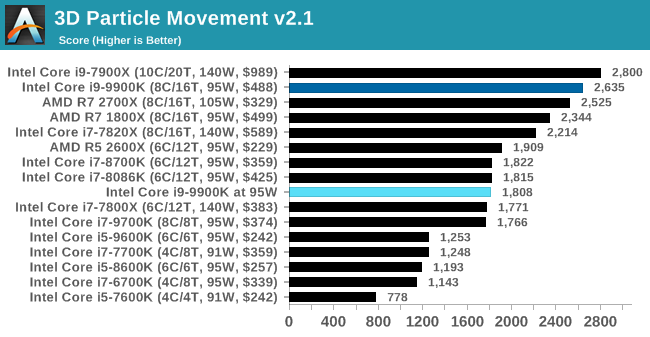
As we move onto something more substantial with all the threads, the 95W setting means that the result scores a heavy loss in 3DPM.
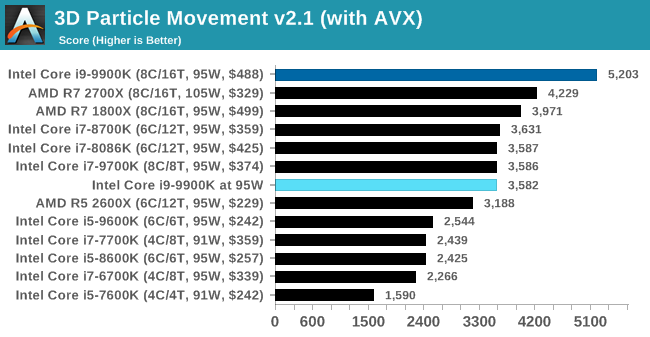
Dolphin 5.0: Console Emulation
One of the popular requested tests in our suite is to do with console emulation. Being able to pick up a game from an older system and run it as expected depends on the overhead of the emulator: it takes a significantly more powerful x86 system to be able to accurately emulate an older non-x86 console, especially if code for that console was made to abuse certain physical bugs in the hardware.
For our test, we use the popular Dolphin emulation software, and run a compute project through it to determine how close to a standard console system our processors can emulate. In this test, a Nintendo Wii would take around 1050 seconds.
The latest version of Dolphin can be downloaded from https://dolphin-emu.org/
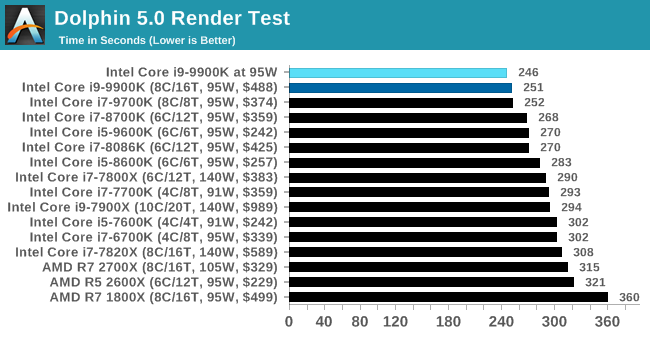
Dolphin is again a single threaded test, and the 9900K at 95W eeks out another small win.
DigiCortex 1.20: Sea Slug Brain Simulation
This benchmark was originally designed for simulation and visualization of neuron and synapse activity, as is commonly found in the brain. The software comes with a variety of benchmark modes, and we take the small benchmark which runs a 32k neuron / 1.8B synapse simulation, equivalent to a Sea Slug.
Example of a 2.1B neuron simulation
We report the results as the ability to simulate the data as a fraction of real-time, so anything above a ‘one’ is suitable for real-time work. Out of the two modes, a ‘non-firing’ mode which is DRAM heavy and a ‘firing’ mode which has CPU work, we choose the latter. Despite this, the benchmark is still affected by DRAM speed a fair amount.
DigiCortex can be downloaded from http://www.digicortex.net/
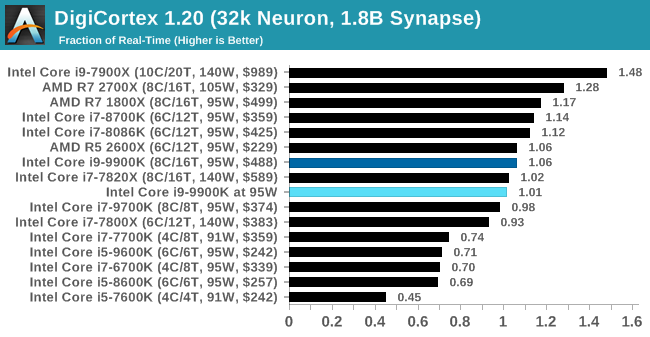
When it comes to a mixed benchmark like DigiCortex, the reduced power CPU actually performs around the same, given the same DRAM speed on both setups.
y-Cruncher v0.7.6: Microarchitecture Optimized Compute
I’ve known about y-Cruncher for a while, as a tool to help compute various mathematical constants, but it wasn’t until I began talking with its developer, Alex Yee, a researcher from NWU and now software optimization developer, that I realized that he has optimized the software like crazy to get the best performance. Naturally, any simulation that can take 20+ days can benefit from a 1% performance increase! Alex started y-cruncher as a high-school project, but it is now at a state where Alex is keeping it up to date to take advantage of the latest instruction sets before they are even made available in hardware.
For our test we run y-cruncher v0.7.6 through all the different optimized variants of the binary, single threaded and multi-threaded, including the AVX-512 optimized binaries. The test is to calculate 250m digits of Pi, and we use the single threaded and multi-threaded versions of this test.
Users can download y-cruncher from Alex’s website: http://www.numberworld.org/y-cruncher/
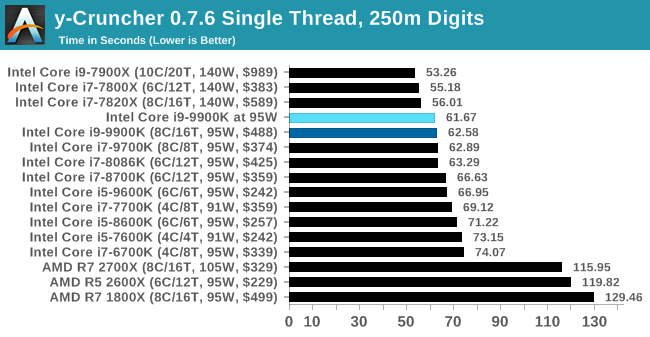
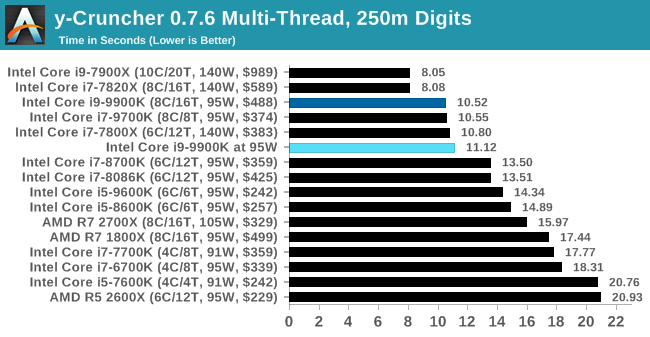
yCruncher shows another small win for the 9900K at 95W in single threaded mode, although this turns into a loss when all the threads are primed with AVX2 code.
Agisoft Photoscan 1.3.3: 2D Image to 3D Model Conversion
One of the ISVs that we have worked with for a number of years is Agisoft, who develop software called PhotoScan that transforms a number of 2D images into a 3D model. This is an important tool in model development and archiving, and relies on a number of single threaded and multi-threaded algorithms to go from one side of the computation to the other.
In our test, we take v1.3.3 of the software with a good sized data set of 84 x 18 megapixel photos and push it through a reasonably fast variant of the algorithms, but is still more stringent than our 2017 test. We report the total time to complete the process.
Agisoft’s Photoscan website can be found here: http://www.agisoft.com/
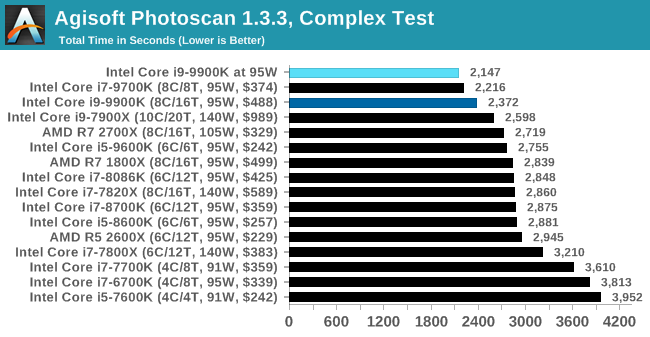
Photoscan is a mixed workload test, with certain portions being purely singe threaded and others being multithreaded. The 9900K at 95W wins by a good amount here.













101 Comments
View All Comments
edzieba - Thursday, November 29, 2018 - link
The difference is the ARM chips being labelled with the short-term term frequencies and performance, while Intel put the steady state values on the box. Motherboard manufacturers throw the box values right out the window, but if Intel were to dictate /those/ the wailing and gnashing of teeth from the peanut gallery would be cacaphonous.melgross - Thursday, November 29, 2018 - link
Its just a matter of semantics. It doesn’t have to be spelled out.Targon - Thursday, November 29, 2018 - link
There are actually three primary states. Base clocks, boost or turbo speeds, and then you can get thermal throttle which will actually lower the speed below the base clock speed. If the i9-9900k has a base of 3.6GHz, a turbo that goes up to 5GHz, but you have poor cooling, you may be seeing the CPU sticking to that 3.6GHz, or even below it if the temperatures get too high.This is where those very thin laptops may have Ryzen versions performing better than Intel, because of the temperatures keeping the chip running at or even below base speeds. For a small form factor machine, will the 9900k be running at base speeds ALL THE TIME due to temperatures/TDP/cooling? In the same small form factor case, would a Ryzen 7 2700X end up having a similar level of performance after several hours(to allow the heat generation to stabilize)? If you start when things are COLD, you could turn the machine on and run benchmarks, and see better numbers than if the machine were already on and you had been running intensive applications for several hours prior to running the benchmarks.
eastcoast_pete - Thursday, November 29, 2018 - link
@Ian: Thanks for this informative test and review. One comment, one question/request. Comment: I continue to be struck by Intel's prowess when AVX512/AVX2 comes into play. I am also (negatively) impressed by the thermal load use of these instructions causes. The reduction in performance when using AVX512/AVX2 under strict adherence to a TdP of 95 Wh speaks volumes. Did you ever have a chance to ask Intel why running AVX makes their chips so power-hungry? Even if not, I'd appreciate your thoughts on why AVX makes Intel's chips run so hot.Here my question/request: I now that you/Anandtech have a large dataset on x264 video encoding speeds. However, especially for i7s and AMD's six-core and up Zen chips, I'd like to know how they fare when encoding/transcoding a 2160p 10bit video, as that is now in increasing demand, and really makes the processor sweat (and slow down, a lot). Any chance you and your colleagues can add that to the encoding tests? If space is an issue, I suggest to dump the x264 720p speed test; even a lowly Athlon or Celeron chip does that quite well, and at good speed.
HStewart - Thursday, November 29, 2018 - link
I believe you can turn off AVX512 in bios - it use in special application that need the speedAlso I would think the external GPU's is another major factor in considering power requirements on a system.
I don't belkieve there is any power needs or reduction in topp speed for AVX2 only that AVX512 uses extra power on system and top frequency are reduce if being used.
One thing about AVX2 - on Intel it is 256bit and AMD has dual 128 bits currently - not sure about new Zen's coming out next year. But at least with PowerDirector, it give you significantly performance increase
GreenReaper - Saturday, December 1, 2018 - link
It's pretty simple, really: the more data the CPU has to process in parallel, the more horsepower it uses. It's like doubling or quadrupling the number of active cylinders in an engine - you gain performance, but it requires more power and produces more heat. That's why they're off if not in use.Dedicated GPU blocks for video coding will also use more power, but are likely to be far more efficient than doing the operations with general code - as long as it's within their defined capabilities. (Similarly, if you had to do the equivalent of the AVX operations without the relevant hardware, it would probably use even more power than it currently does, at least over the extra time it took.)
Davenreturns - Thursday, November 29, 2018 - link
I have found much confusion among the readers on hardware review websites when it comes to this issue. So I would like to present some information from Anandtech's Bench tool in order to clarify the situation for me and others hopefully:Looking at the CPU Power Bench
https://www.anandtech.com/bench/CPU-2019/2194
The following two processors have these results under full package, full load:
i7-6700k 82.55W First mainstream desktop 14 nm processor, 95W TDP according to Intel
i9-9900k 168.48W Latest mainstream desktop 14 nm processor, 95W TDP according to Intel
I assume that these two values were measured in unlimited mode. If this is the case, this means that the power listed above is when all cores/threads are loaded at full max turbo mode. So if you are expecting a certain level of performance given that Intel advertises 95W for both CPUs, then you are being misled and may not get the performance you are expecting when upgrading the CPU but not your cooling.
This is a CHANGE from the past in how Intel uses TDP without telling the customer. It also highlights that Intel use to be conservative with cores/clocks/turbo when they had no competition and were able to shrink nodes between Nehalem and Skylake. Now they are PRETENDING that they can just double the cores and raise clocks on the same node and not increase power. Please correct me if I'm wrong, but it doesn't look like this is the case anymore.
AlyxSharkBite - Thursday, November 29, 2018 - link
Really interesting how when you limit it to 95W it’s really close to the 2700X4800z - Thursday, November 29, 2018 - link
A power unlimited 2700x. Also this article doesn't include any games. If it did you'd see the 9900k still does much better, because games don't use all 8 cores.schujj07 - Thursday, November 29, 2018 - link
2700X - 117.18W Max = 11.6% over stated TDP9900K - 168.48W Nax = 77.3% over stated TDP
Don't forget not everyone views gaming and the end all be all form of benchmarking. Would it be interesting to see if it affects the gaming sure. It most certainly would affect those who game and stream at the same time.